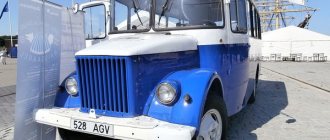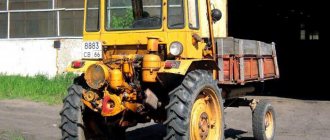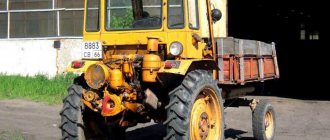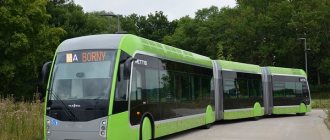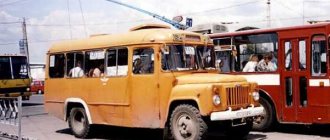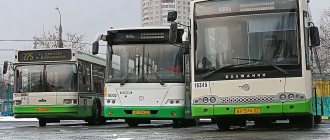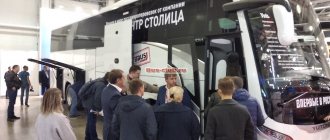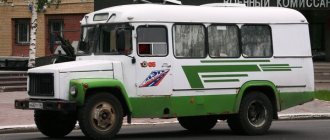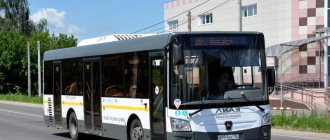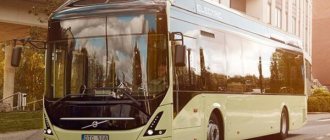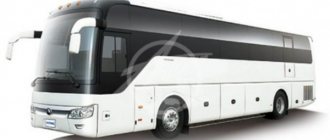Forgotten Penza buses
Mikhail Sokolov Photo from the archive of the author and Igor Shishkin (Penza)
In September 1945, a new, post-war era of peaceful life began for the USSR. The country, devastated by a terrible war, needed a significant number of different cars, including city buses, which so far there was nowhere to get.
There were quite a few of the previous pre-war passenger cars in running condition; moreover, after harsh army service, almost all of them needed serious restoration repairs. The development of fundamentally new designs of carriage-type buses, although resumed immediately after the Victory, was still very far from completion, and there was still no talk of mass production of carriage-type buses. And to serve the population, buses were needed now, urgently, and in considerable quantities.
Good old ZIS-5
The way out of this critical situation was seen not only in restoring as many surviving domestic pre-war buses as possible, as well as foreign ones (captured, exported as reparations, etc.), but also in resuming production of the simplest, cheapest to manufacture and in demand in operation of their models, which were based on the most popular domestic chassis of that time. At that time, these were primarily the chassis of the 3-ton ZIS-5 trucks. The production of “three-ton” cars, albeit simplified ones, at that time increased annually and was carried out at two car factories at once - at the capital’s ZIS and at the UralZIS plant in Miass, Chelyabinsk region. And although all models of hooded buses on the ZIS-5 chassis and its modifications were structurally related to the pre-war era, they at the same time became quite widespread in the post-war USSR, due to their simplicity, mastery and the presence of a sufficiently large number of chassis for their basis.
In the resort areas of the south of the country, the production of open buses with tarpaulin awnings on repaired ZIS-5 chassis has been resumed. However, these simplest and cheapest to manufacture passenger cars with open bodies were only suitable for warm climates and did not in any way solve the problem of a general shortage of public transport.
Engine Specifications
The design of the ZIL 158th model included a six-cylinder in-line lower-valve carburetor gasoline engine with a volume of 5.5 liters. The unit had a compression ratio of 6.5 kilograms per centimeter and a power of 109 horsepower. The torque of this engine was 333.5 Nm at one and a half thousand revolutions.
With this engine, the bus could reach a maximum speed of 65 kilometers per hour on a high-quality highway. At the same time, fuel consumption ranged from 37 to 42 liters per hundred, depending on the operating mode. These are the numbers indicated in the technical description for the ZIL-158. Why such a high consumption? The fact is that this engine was derated (as on ZIL-130 trucks). Because of this, it had a low compression ratio, but could drive on 72 gasoline.
Non-standard "standards"
The pre-war flagship of this direction - the ZIS-16 bus - had many significant flaws, and most importantly, it was labor-intensive to produce and quite expensive. Only the capital's Aremkuz was able to revive the production of buses similar to the 16th (under the AKZ-1 and AKZ-2 brands).
As for the vast majority of cities in the USSR, in order to urgently meet the demand for buses, there was nothing else left to do but to revive for re-production the rather ancient, but not complex and cheap, “Standard” type body of the 1932 model, which became best known as a body bus ZIS-8. Of course, from the point of view of road transport, this was a clear and significant step back, but there was simply no other alternative at that moment. As a result, a lot of old-fashioned and angular ZIS-8 type buses appeared on the streets of many cities of the Soviet Union, but based not on elongated ones, but on standard ZIS-5 chassis.
Drivers about the salon
In the same article, drivers spoke about typical bus breakdowns. Many did not like the too narrow passage in the cabin. In addition, when it rained, water flowed through all three ventilation hatches. It was noticed that the material for the seat upholstery was chosen incorrectly - the seat covering quickly wears out, although the cars have only recently entered the routes. Also, on most cars in many fleets of the country, the frame of the seats in the bus interior failed. The stove was also criticized. Even at high speeds of electric motors, it was impossible to warm up the interior in cold weather.
Passengers on a snowy day preferred, whenever possible, to choose another bus for the trip - each person risked getting off the bus wet. The portholes on the ceiling let in a lot of water.
On the issue of streamlining
And yet, sometimes there were cases when the creators of such buses went much further than simply copying the pre-war “Standard” and produced their own versions of more complex, voluminous and progressive passenger bus bodies. Sometimes quite original variants emerged from the gates of local bodyworks, significantly different from the pre-war “Standard”, although they did not reach the design heights of the ZIS-16 body or the experienced pre-war streamlined style buses (streamline), but still strived to reach their level.
If we turn to an earlier era - the 1920-1930s, we can confidently state that almost every urban economy in the USSR at that time was forced to solve the problem of bus transportation on its own and in its own way. For many cities in our country, this statement turned out to be true for the period of the first post-war years. Moreover, sometimes such forced independence brought very interesting results in terms of creating their own local models of buses on the ZIS-5 chassis.
A striking example of such creativity were the original buses of the post-war era, built in the city of Penza on the ZIS-5 chassis (mostly post-war production) with bodies made in the so-called semi-streamlined style. Here is some interesting information about them contained in the book “Penza Motor Transport: History, Events, People,” published in Penza in 1996:
“In 1939, the Penza Regional Administration had 22 buses, of which fifteen GAZ-03-30, five ZIS-8 and two ZIS-16 buses... After the war in 1946, the workshops of the motor depot managed to restore one decommissioned ZIS-16; and he was allowed on the route “Penza - Nizhny Lomov”. This was the first intercity bus. Then he began to run on the routes “Penza - Kuznetsk” and “Penza - N. Pestrovka”. ...In 1946, the motor transport office was renamed motorcade No. 53... Until 1947, there were no new arrivals of buses. Therefore, on the initiative of the city authorities, plant No. 163 was given an order for the production of bus bodies on the chassis of ZIS-5 vehicles. As a result, the fleet was replenished with twenty such buses.”
"Krymkurso"
In August 1923, the Crimean joint-stock company of resort and intercity communications “Krymkurso” was established in Sevastopol. It was engaged in the operation of railway stations, hotels, rental cars and buses, servicing holidaymakers and tourists arriving in Crimea, and organizing excursions. The industrial cooperative society restored its first car on its own, but then began ordering cars and buses from trading and manufacturing enterprises. In the year of its founding, JSC Krymkurso transported about 7,800 passengers on irregular routes.
The company opened regular road traffic on April 15, 1924, and by the end of the year its 28 cars and 16 buses carried 33,400 passengers. The vehicle fleet and passenger traffic of the “auto artel”, whose shareholders included Avtopromtorg, Krymkommunkhoz and Avtotrest, grew continuously, the fixed capital of the company amounted to 3 million gold rubles. In the spring of 1927, Krymkurso had 58 buses and 31 cars. The buses used were manufactured in the USSR and abroad on chassis of different brands: White-AMO, Ford, Benz, FIAT, Lancia, Renault...
At the end of 1930, JSC "Krymkurso" was liquidated, its buses were transferred to the Sevastopol office of the All-Union Association of Warehousing and Forwarding Business "Soyuztrans".
Furniture, spare parts, incubators
It is interesting that Penza plant No. 163, founded back in 1901 as a Viennese furniture factory, in the pre-war years received an aviation focus and manufactured, in particular, spare parts for I-16 fighters. During the war years, the company mastered the repair of aircraft, and after the Victory it began to produce various aviation instruments and even automatic incubators “Record-39”. But, probably, some of the former furniture production, which was closed in 1935, still remained here, otherwise how to explain the fact that it was here that in a short time they were able to create their own version of the bus body on the ZIS-5 chassis, and, Moreover, give it original and fairly streamlined shapes.
Firstly, Penza bus bodies manufactured at plant No. 163 received inclined planes of the windshield and rear wall of the body. Secondly, a voluminous high roof with pronounced rounded slopes along its entire perimeter. Thirdly, the width of the body noticeably narrows towards the front and rear walls. All this in general allows us to rank this type of body among the bus bodies of the mentioned semi-streamlined style, characteristic of individual domestic bus designs of the mid-1930s. This style was the body itself with obvious elements of rounded, streamlined shapes combined with the usual standard tail of a car chassis.
And finally, another feature of the bus bodies of the Penza plant No. 163 was the very uniquely designed front door windows, the glass of which is quite intricate in shape and very similar to half an ellipse. Due to the obvious asymmetry, they did not reach any of the corners! Nowhere and never in the domestic practice of bodybuilding have such bizarre solutions, most likely caused by the simple presence of just such glass, been encountered!
Of course, this purely local Penza model of a bus on the ZIS-5 chassis did not have any proper name and in everyday life among drivers they were usually referred to simply as “ZIS-5 bus” or, in extreme cases, “bus based on ZIS-5”. Unfortunately, neither body drawings, nor exact technical parameters, nor any other information about the production and operation of this interesting type of post-war buses on the ZIS-5 chassis have survived to this day.
Gearbox, clutch
The clutch system on the ZIL-158, manufactured before 61, was double-disc. It was then replaced with a single-disc design in later versions. At the same time, the housing on the flywheel also changed. Naturally, for those years the clutch was mechanical. The transmission had a fourth direct gear, and the fifth was an overdrive. But the bus transmission was distinguished by a remote shift drive via a rod system. After all, the engine, as befits a bus, was located in the rear of the body.
This car was equipped with a 5-speed manual transmission. But many drivers who worked on this bus believed that there should be a torque converter. The driver had to change gears more than a thousand times during an 8-hour shift. Naturally, there were no synchronizers in the design of the gearbox. This significantly tired drivers.
Ural originals
But despite all the originality of the buses with bodies made by the Penza plant No. 163, they were not the only case in the Soviet Union of the post-war revival of bus bodies, which can be attributed to the semi-streamlined style. Own versions of passenger bodies on the ZIS-5 chassis, very similar to the Penza variety, appeared in the first post-war years in the Urals. Unfortunately, no information has been found to date about the manufacturer of these interesting machines. However, surviving photographic images clearly indicate that here the bodybuilders used almost the same design solutions.
At the turn of the 1940s–1950s, at least two of these buses, with different versions of the bodies, were operated in the city of Kamensk-Uralsky (since 1942 as part of the Sverdlovsk region) and at least one copy traveled around the same time. to Sverdlovsk itself. The chassis of the post-war ZIS-5, most likely made in the Urals, was also used as the basis for these buses. The Ural buses differed from the Penza buses by an even greater backward tilt of the symmetrical two halves of the windshield (the left half of which had an opening upper part); a different number of side side windows (larger for specimens from Kamensk-Uralsky and smaller for the Sverdlovsk specimen); and finally, custom-made windows in the front doors, which had shapes close to trapezoidal.
One can only regret that all these original, but one-off buses with bodies of unknown regional designs served their time and disappeared into oblivion almost without a trace, unnoticed and unappreciated by anyone.
Power unit
The engine that was installed on these buses was a modification of the ZIL-164 unit. The differences were in a different pan, oil receiver and exhaust manifold. We also used a new spacer for mounting the fan, a different generator along with a bracket.
Despite the fact that the engine power was small, the engine turned out to be quite successful for the ZIL-158 model. Due to the presence of a lower valve timing mechanism in the unit, it was possible to easily replace the cylinder head gasket. At low speeds the engine ran very quietly - the noise of the engine was drowned out by the compressor.
The crankshaft was equipped with 7 main and 6 connecting rod journals. Their diameter was 66 and 62 mm. The engine featured a cast iron cylinder block with a deeper crankcase. The block was of the wet type and was cast together with the sleeves. The oil pump and ignition distribution were carried out from the camshaft. It also drove the fuel pump mechanism.
Reply to criticism
The chief engineer of ZIL responded to all these criticisms. After he explained that the characteristics of the ZIL 158 model were fully approved by the government and various authorities, the specialist began to compare the model with foreign analogues.
The engineer pointed out that Western manufacturers install diesel engines - hence the better dynamics. But such engines are undesirable in the USSR on city buses - they cause unnecessary noise and exhaust fumes. There was also an answer from the engineer regarding the torque converter. Installing it will make the driver’s work much more comfortable, but will increase fuel consumption.
The body and rivets were criticized. An interesting fact: upon careful inspection, one could see the so-called accordion on the body. Deformations of this kind were caused by weak aluminum belts. In addition, many also did not like the muffler - it was too loud.
